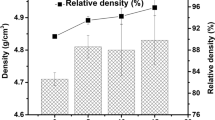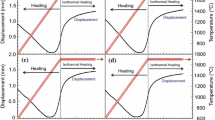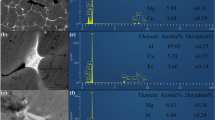Abstract
ZrO2-WC composites exhibit comparable mechanical properties as traditional WC-Co materials, which provides an opportunity to partially replace WC-Co for some applications. In this study, 2 mol.% Y2O3 stabilized ZrO2 composites with 40 vol.% WC were consolidated in the 1150°C-1850°C range under a pressure of 60 MPa by pulsed electric current sintering (PECS). The densification behavior, microstructure and phase constitution of the composites were investigated to clarify the role of the sintering temperature on the grain growth, mechanical properties and thermal stability of ZrO2 and WC components. Analysis results indicated that the composites sintered at 1350°C and 1450°C exhibited the highest tetragonal ZrO2 phase transformability, maximum toughness, and hardness and an optimal flexural strength. Chemical reaction of ZrO2 and C, originating from the graphite die, was detected in the composite PECS for 20 min at 1850°C in vacuum.
Similar content being viewed by others
References
Anné G, Put S, Vanmeensel K, et al. Hard, tough and strong ZrO2-WC composites from nanosized powders. Journal of the European Ceramic Society, 2005, 25(1): 55–63
Jiang D, Van der Biest O, Vleugels J. ZrO2-WC nanocomposites with superior properties. Journal of the European Ceramic Society, 2007, 27(2–3): 1247–1251
Huang S G, Vanmeensel K, Van der Biest O, et al. Development of ZrO2-WC composites by pulsed electric current sintering. Journal of the European Ceramic Society, 2007, 27(10): 3269–3275
Basu B, Lee J H, Kim D Y. Development of WC-ZrO2 nanocomposites by spark plasma sintering. Journal of the American Ceramic Society, 2004, 87(2): 317–319
Malek O J A, Lauwers B, Perez Y, et al. Processing of ultrafine ZrO2 toughened WC composites. Journal of the European Ceramic Society, 2009, 29(16): 3371–3378
Vanmeensel K, Laptev A, Hennicke J, et al. Modelling of the temperature distribution during field assisted sintering. Acta Materialia, 2005, 53(16): 4379–4388
Vanmeensel K, Laptev A, Van der Biest O, et al. The influence of percolation during pulsed electric current sintering of ZrO2-TiN powder compacts with varying TiN content. Acta Materialia, 2007, 55(5): 1801–1811
Anstis G R, Chantikul P, Lawn B R, et al. A critical evaluation of indentation techniques for measuring fracture toughness: I. Direct crack measurements. Journal of the American Ceramic Society, 1981, 64(9): 533–538
ASTM Standard E 1876-99, Test method for dynamic Young’s modulus, shear modulus, and Poisson’s ratio for advanced ceramics by impulse excitation of vibration. ASTM Annual Book of Standards, Philadelphia, PA, 1994
Lange F F. Transformation-toughened ZrO2 correlations between grain size control and composition in the system ZrO2-Y2O3. Journal of the American Ceramic Society, 1986, 69(3): 240–242
Basu B, Vleugels J, Van der Biest O. Toughness tailoring of yttriadoped zirconia ceramics. Materials Science and Engineering A, 2004, 380(1–2): 215–221
Chamberlain A L, Fahrenholtz W G, Hilmas G E. Pressureless sintering of zirconium diboride. Journal of the American Ceramic Society, 2006, 89(2): 450–456
Moskała N, Pyda W. Thermal stability of tungsten carbide in 7mol.% calcia-zirconia solid solution matrix heat treated in argon. Journal of the European Ceramic Society, 2006, 26(16): 3845–3851
Toraya H, Yoshimura M, Somiya S. Calibration curve for quantitative analysis of the monoclinic-tetragonal ZrO2 system by X-ray diffraction. Journal of the American Ceramic Society, 1984, 67: C119–C121
Author information
Authors and Affiliations
Corresponding author
Rights and permissions
About this article
Cite this article
Huang, S., Vanmeensel, K., Van Der Biest, O. et al. Sintering, thermal stability and mechanical properties of ZrO2-WC composites obtained by pulsed electric current sintering. Front. Mater. Sci. 5, 50–56 (2011). https://doi.org/10.1007/s11706-011-0119-3
Received:
Accepted:
Published:
Issue Date:
DOI: https://doi.org/10.1007/s11706-011-0119-3




